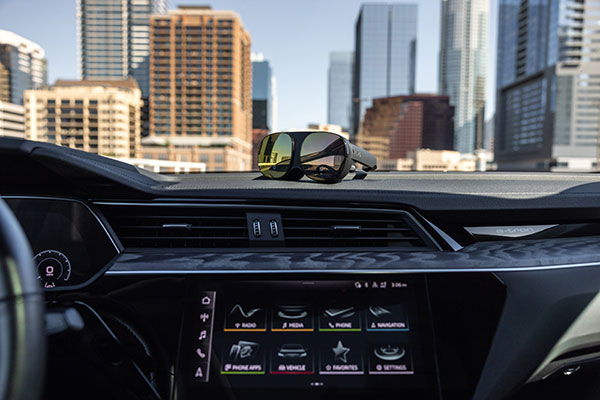Audi Dips Into Automotive VR
Beginning in the summer of 2022, Audi aims to become one of the first manufacturers to convert the automobile into an experience platform for virtual reality, company says.

Select Audi vehicles with the MIB 3 infotainment system manufactured beginning in June 2022 will be holoride-capable. Image courtesy of Audi.
Latest News
March 22, 2022
Audi may be the first automobile manufacturer worldwide to bring virtual-reality entertainment from holoride into series production. Beginning this summer, back seat passengers can put on virtual reality glasses (VR glasses) and immerse themselves in various media formats including games, films and interactive content.
The main attraction: The virtual content adapts to the driving movements of the car in real time. Starting with select vehicles produced beginning in June 2022, Audi models with the latest upgrade of the modular infotainment toolkit (MIB 3) will be holoride-capable. The new technology will be introduced at the South by Southwest (SXSW) festival in Austin, TX. Visitors at the festival will be able to experience holoride in a moving vehicle.
In the future, passengers will be able to use their time on the way from point A to point B for a game experience. From June 2022, passengers in the back seat of an Audi can experience films, video games and interactive content much more realistically using VR glasses. A car ride can become a multimodal gaming event, according to Audi.
holoride is closely associated with South by Southwest. Behind holoride there is a technology that adapts virtual content to the car’s driving movements in real time:
For example, if the car is taking a right turn, the spaceship in the imaginary world will also fly to the right. If the car accelerates, the spaceship speeds up too. Initiated by Audi, development of this VR or XR (extended reality) technology is being advanced and commercialized for different manufacturers by the tech entertainment startup holoride.
With this approach, the Munich-based startup has established a completely new media category that they call “Elastic Content”—content that adapts to driving movements, journey time and driving route.
From June, select models that roll off the line with the third generation modular infotainment toolkit (MIB 3) and the latest software cluster will be holoride-capable. This means: Audi A4, A5, A6, A7, A8, Audi Q5, Q7, Q8, Audi e-tron* and Audi e-tron GT quattro. From June, the Audi models mentioned will be capable of using holoride in the European market, as well as in Canada, the United States, Japan and China.
Availability of holoridewill depend on the individual market. The new startup technology is expected to launch in Germany, the United Kingdom and the U.S. market.
To use holoride, a VR headset that has been enabled for it must be connected with the vehicle. The connection is created wirelessly via Bluetooth Low Energy (BLE).
Holoride
Holoride was first presented at CES 2019 (Consumer Electronics Show) in Las Vegas. In cooperation with Disney Games and Interactive Experiences, holoride implemented a VR game experience from the Marvel Universe for cars. In addition to other activities and showcases, during a roadshow through California from Los Angeles to San Francisco in the summer of 2021, holoride visited other production and game studios to demonstrate the technology’s possibilities to potential partners.
Autonomous Driving Opens Paths
In the future, the progressive automation of travel by car will make new forms of entertainment possible while driving and open up opportunities to learn and work on the road, according to Audi. When drivers also no longer have to concentrate on driving in the future, they can turn their attention to other things—work, reading, watching films or gaming. The motion-synchronized voyage through virtual worlds with holoride may also be able to reduce motion sickness often experienced by passengers reading a book or watching audiovisual media on electronic devices such as tablets.
For users, the interior will become their personal free space, and for designers, it will become the new design center. After all, the design process begins with the question: who will be sitting in a new model and what will people want to do there?
Sources: Press materials received from the company and additional information gleaned from the company’s website.
Subscribe to our FREE magazine, FREE email newsletters or both!
Latest News
About the Author
DE’s editors contribute news and new product announcements to Digital Engineering.
Press releases may be sent to them via [email protected].






